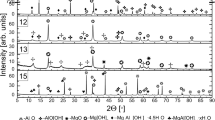Conclusions
The destabilization of solid solutions based on chemically pure technical ZrO2 and baddeleyite of various grades of purity has been compared after prolonged isothermal dwells (up to 240 h). It is established that the use of baddeleyite containing a higher amount of impurity, mainly in the form of anatite, lowers the degree of destabilization of the solid ZrO2 solutions.
The presence of a monoclinic phase in solid solutions obtained from technical ZrO2 or baddeleyite strengthens the destabilization unlike the solid solutions based on chemically pure materials with minimum destabilization. In this case, the density and porosity of the material remains virtually unchanged and its ultimate compressive strength increases significantly. The solid solutions obtained from technical ZrO2 without any addition to the bonding of the monoclinic ZrO2 become looser after a prolonged isothermal dwell and their strength decreases.
An addition of HfO2 leads to a slight increase in the stability of solid solutions in the ZrO2-HfO2-CaO system. The greatest intensity of the decomposition as in the ZrO2-CaO system is observed in the region of 1400°C.
A compound Ca(Zrx, Hf1−x)4O9 is observed where 0≤x≤1 and this has been confirmed by x rays, IR spectroscopy, and by direct observation of the crystals using an electron microscope. In the case of the experimental compositions, when x=0.1 and x=0.3, the maximum of the formation of ordered zones is observed at 1200°C but at 1600°C these zones disappear. A cubic solid solution of the fluorite type has been observed using an x-ray method.
Similar content being viewed by others
Literature cited
A. G. Karaulov, A. A. Grebenyuk, N. V. Gul'ko, et al., Ogneupory, No. 9, 45–51 (1968).
I. M. Demonis and R. Ya. Popil'skii, Silicates: Proc. of D. I. Mendeleev Moscow Chemical-Engineering Institute [in Russian], No. 55 (1967), pp. 151–156.
A. M. Gavrish, B. Ya. Sukharevskii, E. I. Zoz, et al., Izv. Akad. Nauk SSSR, Neorg. Mater.,5, No. 9, 1584–1588 (1969).
A. K. Kuznetsov, P. A. Tikhonov, and É. K. Keler, Ogneupory, No. 8, 44–48 (1976).
A. G. Karaulov, A. A. Grebenyuk, N. M. Sharova, et al., Ogneupory, No. 7, 48–53 (1977).
I. I. Vishnevskii, B. Ya. Sukharevskii, and A. M. Gavrish, Collected Scientific Works of the Ukrainian Scientific-Research Institute of Refractories [in Russian], No. 5 (1961), pp. 315–323.
L. A. Il'yushin, Plasticity [in Russian], Moscow-Leningrad (1948).
C. Delamarre, Rev. Int. Hautes Temp. Ref.,9, 209–224 (1972).
R. Garvie, J. Am. Ceram. Soc.,51, No. 10, 553–556 (1968).
Yu. A. Pyatenko, Dokl. Akad. Nauk SSSR,173, 634–637 (1967).
D. Michel, Rev. Int. Hautes Temp. Ref.,9, 225–241 (1972).
A. I. Leonov, Yu. P. Kostikov, I. K. Ivanov, et al., Izv. Akad. Nauk SSSR, Neorg. Mater.,15, No. 11, 1974–1977 (1979).
N. T. McDevit and W. L. Baun, J. Am. Ceram. Soc.,43, No. 3, 662–663 (1964).
Author information
Authors and Affiliations
Additional information
Translated from Ogneupory, No. 9, pp. 51–57, September, 1981.
Rights and permissions
About this article
Cite this article
Karaulov, A.G., Zoz, E.I., Rudyak, I.N. et al. Phase transformations after long-term heat treatment of solid solutions based on ZrO2 and HfO2 . Refractories 22, 489–495 (1981). https://doi.org/10.1007/BF01406888
Issue Date:
DOI: https://doi.org/10.1007/BF01406888




